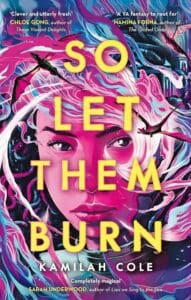Kamilah Cole on how Joan of Arc inspired her debut novel, So Let Them Burn
"Any honors student can tell you that the accolades and the compliments dry up the older you get."
This post was written by Kamilah Cole, author of So Let Them Burn.
I don’t remember when I first learned the tragic history of Joan of Arc, but, in hindsight, it’s no surprise that my debut novel, SO LET THEM BURN, adapts her story.
It doesn’t matter where and when I first learned it. It matters that I never forgot it. Elements of her history followed me throughout my life. Jehanne d’Arc—as she was known in Middle French—was thirteen when she first claimed to hear the voices of saints and nineteen when she was burned as a witch. Every significant thing she did in her life was done in her teens, not unlike the characters from my favorite Young Adult novels. When I was a teen, I was determined for this to be my story as well, that I would publish my first book like Amelia Atwater-Rhodes and Christopher Paolini and go down in history as some sort of literary prodigy.
Thank goodness I didn’t. I needed the two decades it took me to write SO LET THEM BURN in order to be the kind of writer who could do this story justice.
As a child, what impressed me about Joan of Arc was how much she managed to accomplish so young. She left her home. She went to war. She became a patron saint of France despite never seeing her 20s. But now, at 33, I see that for the tragedy that it is. Joan was a child on a holy mission, who never got to reckon with her lost childhood before she died. She is renowned for what, I imagine, she would consider the worst times in her life. One day, not long after Zendaya appeared as Joan of Arc for the 2018 Met Gala, I found myself asking a question I had never considered before: “What if Joan had lived to see her country liberated?”
SO LET THEM BURN became my attempt to answer it.
View this post on Instagram
As a former gifted kid, I’ve never done anything as illustrious as fighting for my country’s independence, but I have amble experience in feeling like you’ve peaked at a young age. Any honors student can tell you that the accolades and the compliments dry up the older you get. Your accomplishments become expected rather than praised for the simple act of doing them so young.
Would Joan, I wonder, still be lauded for her preternatural military knowledge? Or would her involvement in politics become annoying when she was no longer a woman child but just a woman? Would the voices of the saints abandon her if she survived or would she still be having visions well into adulthood? Can you return to a normal life after fighting a war when you were only thirteen or is the person you became to survive fundamentally incapable of settling down?
Through my main character, Faron Vincent, I explore many of these questions. Like Joan, she heard the voices of her deities telling her to liberate her island of San Irie. Like Joan, she wields powers that people consider legendary miracles. Like Joan, despite all efforts to protect her, she ended up on the battlefields anyway. And, unlike Joan, she lived to see the after of her legend—and, quite frankly, it sucks. Faron is resentful. She suffers from PTSD. She has no purpose in peacetime. The gods won’t leave her alone. The worship she still gains from her feats prevent her from making genuine connections. She is isolated, reckless, and handling everything in the worst way possible.
I don’t know that Joan of Arc would see herself in Faron; Faron is, after all, a Black woman, and Joan of Arc is from a time when she likely hadn’t seen many of them. But I had to leave my teens before I could see that for all her accomplishments and victories, she was just a child. And SO LET THEM BURN is my attempt at reckoning with her legacy—the good and the bad.
 Get your copy of So Let Them Burn by Kamilah Cole here.
Get your copy of So Let Them Burn by Kamilah Cole here.



 (@thenovl)
(@thenovl)